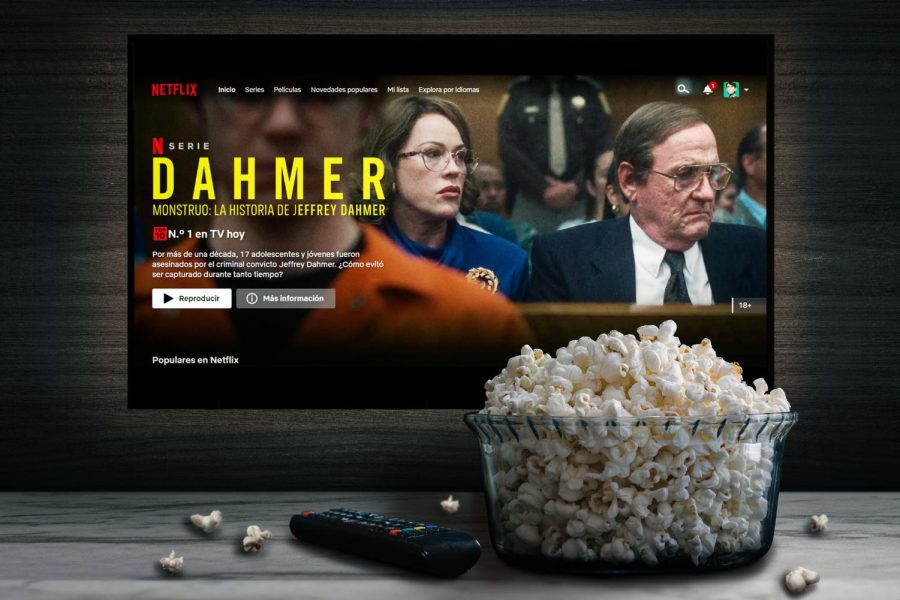“Dahmer” Controversy
“Scene from ‘Dahmer Monster: The Jeffrey Dahmer story’ behind a bowl of popcorn and a remote control.
On Sept. 21, 2022, Netflix released a new documentary series, Monster: The Jeffrey Dahmer Story, which re-tells the life and crimes of the serial killer Jeffrey Dahmer. The new series is the second re-telling film that has come out in the last five years and the third to come out in the previous decade about Dahmer. In 2002, Jeremey Renner initially played him; in 2017, Ross Lynch starred in My Friend Dahmer. The most recent release, Monster: The Jeffrey Dahmer Story, was created by Ryan Murphy and Ian Brennan and starred Evan Peters.
Dahmer, was known as the infamous Milwaukee Cannibal Monster, terrorized Milwaukee, Wisconsin, from 1978-1991 as an American serial killer and sex offender who committed the murders and dismemberment of seventeen young boys and men. Dahmer’s crimes involved necrophilia, cannibalism and the preservation of body parts. Although he was later diagnosed with borderline personality disorder, schizotypal personality disorder and a psychotic disorder, he was declared legally sane at his trial. Dahmer was sentenced to fifteen terms of life imprisonment on Feb. 17, 1992. On Nov. 28, 1994, Dahmer was beaten to death by Christopher Scarver, a fellow inmate at the Columbia Correctional Institution in Portage, Wisconsin.
The recent Dahmer series has become one of the most controversial shows Netflix has released. When the series was first announced, it was claimed to highlight the victims and give their families a voice. Essentially, an episode would highlight a couple of victims at once. Instead, the series entirely follows Dahmer, his upbringing and his compulsion.
Families of the victims subjected the film to criticism after its immediate release. With the lack of representation of the victims and the false events that the show documented, there has been more criticism than teaching.
For instance, the only victim recognized throughout the short documentary was Tony Hughes. The episode illustrates Hughes and Dahmer having a real relationship, signifying Dahmer’s limited humanity. Throughout the episode, the audience sees Hughes’ family and the development of his relationship with Dahmer. Showing their multiple dates and the final moments leading Dahmer to kill Hughes. Except that relationship never happened. Upsetting Hughes family but, most importantly, spreading untrue events and victimizing Hughes again.
Although the series primarily shows the truth about Dahmer and his crimes, it is informative. Except considering its original intentions were to give the victims recognition, the series falls short for the families.
In a promotional video for the documentary, Peters mentioned that the series attempts to highlight the stories of the victims. “It’s called The Jeffrey Dahmer Story, but it’s not just him and his backstory: It’s the repercussions, it’s how society and our system failed to stop him multiple times because of racism, homophobia,” Peters said. “It’s just a tragic story.”
Aside from the lack of representing the victims and their families, controversy grew over how Netflix labeled the documentary. The series was tagged “Horror,” “Dark,” “Psychological,” and “LGBTQ.” It was a shock to many that it was filed under the “LGBTQ” tag, while it technically demonstrates LGBTQ, it is not a correct representation considering the show highlights the brutal murders of queer men of color.
While Monster: The Jeffrey Dahmer Story has become one of the most-watched shows since its debut, the line between being informative and wrongfully representing events is blurred. True crime series have become one of the most popular and anticipated types of shows and movies in our current society.
However, do documentaries do more harm than good? Do they highlight the victims’ stories or glorify the killers? Although true crime does inform an audience of potential signs of someone dangerous, it poorly represents the victims and their families. It is so important to recognize how to be careful around uncertain people but also give remembrance to those who suffered.

Hi everyone! My name is Kaelin Collar, and I'm a sophomore majoring in biology on a pre-medical track from Oregon. I've been with The Prairie News for...



















